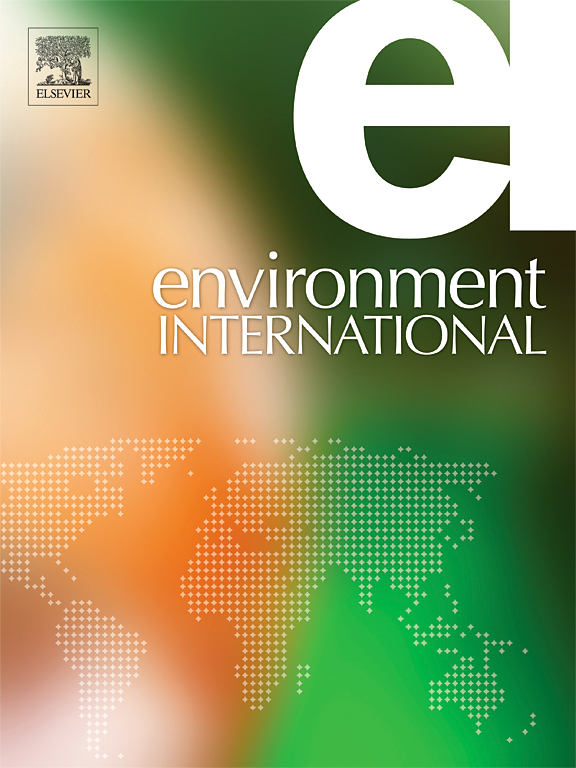In-vitro impacts of glyphosate on manatee lymphocytes
IF 10.3
1区 环境科学与生态学
Q1 ENVIRONMENTAL SCIENCES
引用次数: 0
Abstract
Exposure to contaminants, such as the herbicide glyphosate, can suppress protective immune functions. Glyphosate is the herbicide most used worldwide and has been found in plasma of more than 50 % of the Florida manatees and all-year-round in their aquatic environment. Our objectives were to analyze the consequences of glyphosate exposure on their immune responses via T-lymphocyte proliferation assays and transcriptomics. We isolated peripheral blood mononuclear cells (mainly lymphocytes) of free-ranging manatees and performed T-cell proliferation assays. We used transcriptomics to understand the consequences of glyphosate in vitro exposure. The 3 doses chosen ranged from environmentally relevant concentrations at 10 to 10,000 µg.L-1 that is considered a contamination scenario. Glyphosate caused a dose-dependent reduction in T-lymphocyte proliferation, with a significant mean reduction of 27.3 % at 10,000 µg.L-1 and up to 51.5 % in some individuals. Additionally, T-lymphocyte proliferation was significantly reduced in mid-winter compared to early winter. Transcriptomic analysis of peripheral blood mononuclear cells indicated that all doses of glyphosate (10, 1,000 and 10,000 µg.L-1) resulted in up-regulation of genes related to acute phase inflammation and inhibition of the T-lymphocyte proliferation pathway. Exposure to this contaminant along with other environmental stressors, such as extreme winters and red tide, might further affect the adaptive immune response of this threatened species.

草甘膦对海牛淋巴细胞的体外影响
接触除草剂草甘膦等污染物会抑制保护性免疫功能。草甘膦是全球使用最多的除草剂,在 50% 以上佛罗里达海牛的血浆中发现了草甘膦,并且常年存在于它们的水生环境中。我们的目标是通过 T 淋巴细胞增殖试验和转录组学分析接触草甘膦对海牛免疫反应的影响。我们分离了放养海牛的外周血单核细胞(主要是淋巴细胞),并进行了 T 细胞增殖试验。我们利用转录组学了解草甘膦体外暴露的后果。所选的 3 种剂量从 10 到 10,000 µg.L-1 的环境相关浓度不等,这被认为是一种污染情况。草甘膦会导致 T 淋巴细胞增殖随剂量而减少,10,000 µg.L-1 时平均减少 27.3%,在某些个体中甚至高达 51.5%。此外,与初冬相比,仲冬的 T 淋巴细胞增殖明显减少。外周血单核细胞的转录组分析表明,草甘膦的所有剂量(10、1,000 和 10,000 µg.L-1)都会导致与急性期炎症有关的基因上调,并抑制 T 淋巴细胞增殖途径。暴露于这种污染物以及其他环境应激因素(如极端冬季和赤潮)可能会进一步影响这种濒危物种的适应性免疫反应。
本文章由计算机程序翻译,如有差异,请以英文原文为准。
求助全文
约1分钟内获得全文
求助全文
来源期刊

Environment International
环境科学-环境科学
CiteScore
21.90
自引率
3.40%
发文量
734
审稿时长
2.8 months
期刊介绍:
Environmental Health publishes manuscripts focusing on critical aspects of environmental and occupational medicine, including studies in toxicology and epidemiology, to illuminate the human health implications of exposure to environmental hazards. The journal adopts an open-access model and practices open peer review.
It caters to scientists and practitioners across all environmental science domains, directly or indirectly impacting human health and well-being. With a commitment to enhancing the prevention of environmentally-related health risks, Environmental Health serves as a public health journal for the community and scientists engaged in matters of public health significance concerning the environment.
 求助内容:
求助内容: 应助结果提醒方式:
应助结果提醒方式:


